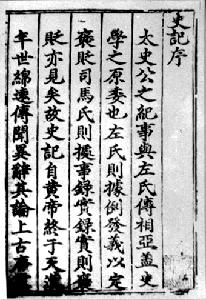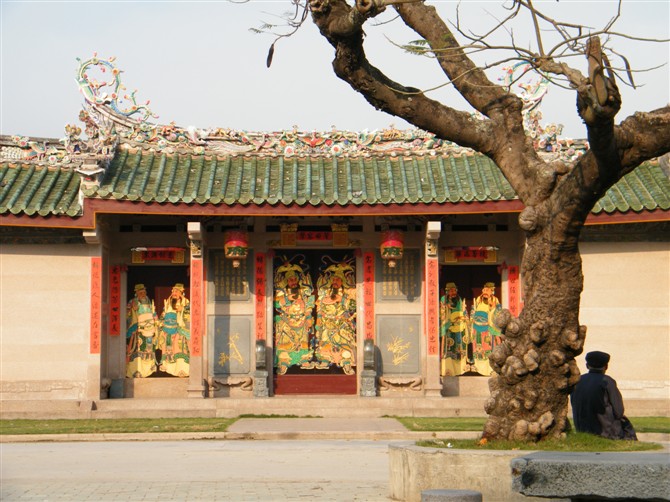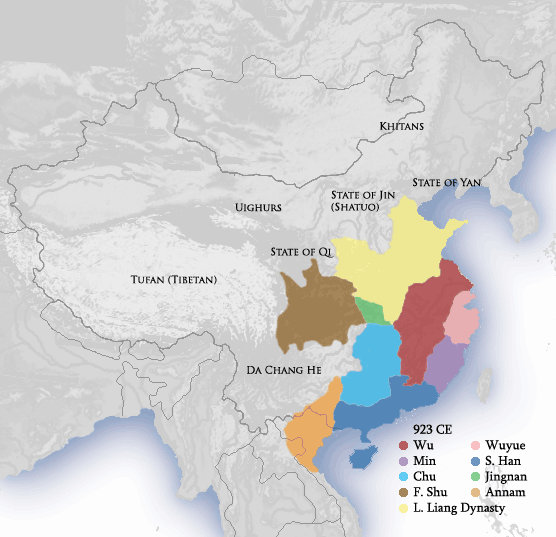|
Book Of Origins
The ''Shiben'' or ''Book of Origins'' ( Pinyin: ''shìběn''; Chinese; 世本; ) was an early Chinese encyclopedia which recorded imperial genealogies from the mythical Three Sovereigns and Five Emperors down to the late Spring and Autumn period (771–476 BCE), explanations of the origin of clan names, and records of legendary and historical Chinese inventors. It was written during the 2nd century BC at the time of the Han dynasty. Title The title combines the common Chinese words ''shì'' 世 "generation; epoch; hereditary; world" and ''běn'' 本 "root; stem; origin; fundament; wooden tablet". The personal name of Emperor Taizong of Tang (r. 627–650) was ''Shimin'' 世民, and owing to the strict naming taboo against writing an emperor's name, the ''Shiben'' 世本 title was changed to ''Xiben'' 系本 or ''Daiben'' 代本 (with the ''shi'' near-synonyms of ''xi'' 系 "system; series; family" and ''dai'' 代 "substitute; generation; dynasty"). Although this Chinese t ... [...More Info...] [...Related Items...] OR: [Wikipedia] [Google] [Baidu] |
Small Seal Script
The small seal script (), or Qin script (, ''Qínzhuàn''), is an archaic form of Chinese calligraphy. It was standardized and promulgated as a national standard by the government of Qin Shi Huang, the founder of the Chinese Qin dynasty. Name Xiaozhuan, formerly romanized as Hsiao-chuan, is also known as the seal script or lesser seal script. History Before the Qin conquest of the six other major warring states of Zhou China, local styles of characters had evolved independently of one another for centuries, producing what are called the "Scripts of the Six States" (), all of which are included under the general term " great seal script". However, under one unified government, the diversity was deemed undesirable as it hindered timely communication, trade, taxation, and transportation, and as independent scripts might be used to represent dissenting political ideas. Hence, Emperor Qin Shi Huang mandated the systematic unification of weights, measures, currencies, etc. ... [...More Info...] [...Related Items...] OR: [Wikipedia] [Google] [Baidu] |
Records Of The Grand Historian
''Records of the Grand Historian'', also known by its Chinese name ''Shiji'', is a monumental history of China that is the first of China's 24 dynastic histories. The ''Records'' was written in the early 1st century by the ancient Chinese historian Sima Qian, whose father Sima Tan had begun it several decades earlier. The work covers a 2,500-year period from the age of the legendary Yellow Emperor to the reign of Emperor Wu of Han in the author's own time, and describes the world as it was known to the Chinese of the Western Han dynasty. The ''Records'' has been called a "foundational text in Chinese civilization". After Confucius and the First Emperor of Qin, "Sima Qian was one of the creators of Imperial China, not least because by providing definitive biographies, he virtually created the two earlier figures." The ''Records'' set the model for all subsequent dynastic histories of China. In contrast to Western historical works, the ''Records'' do not treat history as "a ... [...More Info...] [...Related Items...] OR: [Wikipedia] [Google] [Baidu] |
Zupu
A Chinese kin, lineage or sometimes rendered as clan, is a patrilineal and patrilocal group of related Chinese people with a common surname sharing a common ancestor and, in many cases, an ancestral home. Description Chinese kinship tend to be strong in southern China, reinforced by ties to an ancestral village, common property, and often a common spoken Chinese dialect unintelligible to people outside the village. Kinship structures tend to be weaker in northern China, with clan members that do not usually reside in the same village nor share property. ''Zupu''—the genealogy book A ''zupu'' () is a Chinese kin register or genealogy book, which contains stories of the kin's origins, male lineage and illustrious members. The register is usually updated regularly by the eldest person in the extended family, who hands on this responsibility to the next generation. The "updating" of one's ''zupu'' () is a very important task in Chinese tradition, and can be traced back thousan ... [...More Info...] [...Related Items...] OR: [Wikipedia] [Google] [Baidu] |
Former Shu
Great Shu (Chinese: 大蜀, Pinyin: Dàshǔ) called in retrospect Former Shu (Chinese: 前蜀, Pinyin: Qiánshǔ) or occasionally Wang Shu (王蜀), was one of the Ten Kingdoms formed during the chaotic period between the rules of the Tang dynasty and the Song dynasty. It existed in 907–925 CE. It was the third state named "Shu" on the same territory, the second one having been Shu Han. The country's name changed from "Shu" to "Han" (Chinese: 漢, Pinyin: Hàn) in 917–918, which is not to be confused with another contemporaneous Chinese kingdom during the same Five Dynasties and Ten Kingdoms period, the Southern Han (), 917–971 CE. Founding of the Former Shu Wang Jian was named military governor of western Sichuan by the Tang court in 891. As the Tang Dynasty weakened and eventually fell in 907, Wang was able to expand his holdings into eastern Sichuan and took the title of emperor as the Tang fell in 907. Geographical extent of the Former Shu The Shu was based i ... [...More Info...] [...Related Items...] OR: [Wikipedia] [Google] [Baidu] |
Sui Dynasty
The Sui dynasty (, ) was a short-lived imperial dynasty of China that lasted from 581 to 618. The Sui unified the Northern and Southern dynasties, thus ending the long period of division following the fall of the Western Jin dynasty, and laying the foundations for the much longer lasting Tang dynasty. Founded by Emperor Wen of Sui, the Sui dynasty capital was Chang'an (which was renamed Daxing, modern Xi'an, Shaanxi) from 581–605 and later Luoyang (605–18). Emperors Wen and his successor Yang undertook various centralized reforms, most notably the equal-field system, intended to reduce economic inequality and improve agricultural productivity; the institution of the Five Departments and Six Board (五省六曹 or 五省六部) system, which is a predecessor of Three Departments and Six Ministries system; and the standardization and re-unification of the coinage. They also spread and encouraged Buddhism throughout the empire. By the middle of the dynasty, the ... [...More Info...] [...Related Items...] OR: [Wikipedia] [Google] [Baidu] |
Reference Works
A reference work is a work, such as a paper, book or periodical (or their electronic equivalents), to which one can refer for information. The information is intended to be found quickly when needed. Such works are usually ''referred'' to for particular pieces of information, rather than read beginning to end. The writing style used in these works is informative; the authors avoid use of the first person, and emphasize facts. Indices are a common navigation feature in many types of reference works. Many reference works are compiled by a team of contributors whose work is coordinated by one or more editors, rather than by an individual author. Updated editions are usually published as needed, in some cases annually (''Whitaker's Almanack'', '' Who's Who''). Reference works include almanacs, atlases, bibliographies, biographical sources, catalogs such as library catalogs and art catalogs, concordances, dictionaries, directories such as business directories and telephon ... [...More Info...] [...Related Items...] OR: [Wikipedia] [Google] [Baidu] |
Wang Mo
Wang Mo (traditional Chinese: ; simplified Chinese: ; pinyin: Wáng Mó; Wade-Giles: Wang Mo) (born 1895) was a politician and educator in the Republic of China. He was an important politician during the Wang Jingwei regime (Republic of China-Nanjing). He was born in Yilong, Sichuan. Biography Wang Mo went to Japan where he graduated the Tokyo Teacher's High School (; Now, the Tokyo University of Education, ) and the Tokyo Imperial University. Later he returned to China, he successively held the positions of Professor of the National University of Wuchang (), National University of Beiping (), Teacher's College () and Tsinghua University.Asahi Shimbun, November 12, 1943, p.2. And he was also elected to Senator of the Beijing Government. Later he worked as president of the National Teacher's University of Beiping (), from 1942, he also worked for the professor this University. In November 1943, upon the North China Political Council () was reformed, Wang Mo was catapulted to ... [...More Info...] [...Related Items...] OR: [Wikipedia] [Google] [Baidu] |
Qing Dynasty
The Qing dynasty ( ), officially the Great Qing,, was a Manchu-led imperial dynasty of China and the last orthodox dynasty in Chinese history. It emerged from the Later Jin dynasty founded by the Jianzhou Jurchens, a Tungusic-speaking ethnic group who unified other Jurchen tribes to form a new "Manchu" ethnic identity. The dynasty was officially proclaimed in 1636 in Manchuria (modern-day Northeast China and Outer Manchuria). It seized control of Beijing in 1644, then later expanded its rule over the whole of China proper and Taiwan, and finally expanded into Inner Asia. The dynasty lasted until 1912 when it was overthrown in the Xinhai Revolution. In orthodox Chinese historiography, the Qing dynasty was preceded by the Ming dynasty and succeeded by the Republic of China. The multiethnic Qing dynasty lasted for almost three centuries and assembled the territorial base for modern China. It was the largest imperial dynasty in the history of China and in 1790 ... [...More Info...] [...Related Items...] OR: [Wikipedia] [Google] [Baidu] |
Song Dynasty
The Song dynasty (; ; 960–1279) was an imperial dynasty of China that began in 960 and lasted until 1279. The dynasty was founded by Emperor Taizu of Song following his usurpation of the throne of the Later Zhou. The Song conquered the rest of the Ten Kingdoms, ending the Five Dynasties and Ten Kingdoms period. The Song often came into conflict with the contemporaneous Liao, Western Xia and Jin dynasties in northern China. After retreating to southern China, the Song was eventually conquered by the Mongol-led Yuan dynasty. The dynasty is divided into two periods: Northern Song and Southern Song. During the Northern Song (; 960–1127), the capital was in the northern city of Bianjing (now Kaifeng) and the dynasty controlled most of what is now Eastern China. The Southern Song (; 1127–1279) refers to the period after the Song lost control of its northern half to the Jurchen-led Jin dynasty in the Jin–Song Wars. At that time, the Song court retreated south o ... [...More Info...] [...Related Items...] OR: [Wikipedia] [Google] [Baidu] |
Tang Dynasty
The Tang dynasty (, ; zh, t= ), or Tang Empire, was an imperial dynasty of China that ruled from 618 to 907 AD, with an interregnum between 690 and 705. It was preceded by the Sui dynasty and followed by the Five Dynasties and Ten Kingdoms period. Historians generally regard the Tang as a high point in Chinese civilization, and a golden age of cosmopolitan culture. Tang territory, acquired through the military campaigns of its early rulers, rivaled that of the Han dynasty. The Lǐ family () founded the dynasty, seizing power during the decline and collapse of the Sui Empire and inaugurating a period of progress and stability in the first half of the dynasty's rule. The dynasty was formally interrupted during 690–705 when Empress Wu Zetian seized the throne, proclaiming the Wu Zhou dynasty and becoming the only legitimate Chinese empress regnant. The devastating An Lushan Rebellion (755–763) shook the nation and led to the decline of central authority in the dynas ... [...More Info...] [...Related Items...] OR: [Wikipedia] [Google] [Baidu] |





